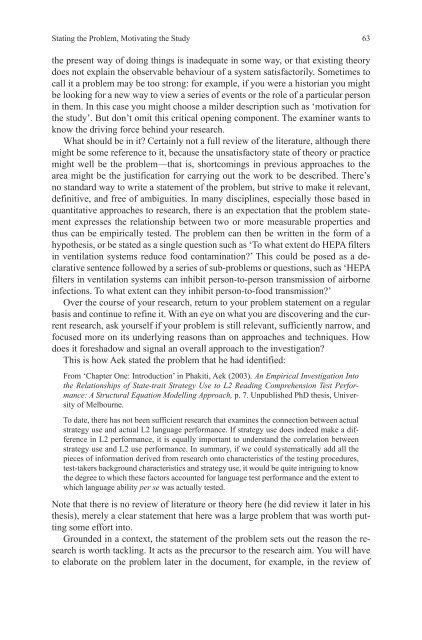How-to-Write-a-Better-Thesis
You also want an ePaper? Increase the reach of your titles
YUMPU automatically turns print PDFs into web optimized ePapers that Google loves.
Stating the Problem, Motivating the Study<br />
63<br />
the present way of doing things is inadequate in some way, or that existing theory<br />
does not explain the observable behaviour of a system satisfac<strong>to</strong>rily. Sometimes <strong>to</strong><br />
call it a problem may be <strong>to</strong>o strong: for example, if you were a his<strong>to</strong>rian you might<br />
be looking for a new way <strong>to</strong> view a series of events or the role of a particular person<br />
in them. In this case you might choose a milder description such as ‘motivation for<br />
the study’. But don’t omit this critical opening component. The examiner wants <strong>to</strong><br />
know the driving force behind your research.<br />
What should be in it? Certainly not a full review of the literature, although there<br />
might be some reference <strong>to</strong> it, because the unsatisfac<strong>to</strong>ry state of theory or practice<br />
might well be the problem—that is, shortcomings in previous approaches <strong>to</strong> the<br />
area might be the justification for carrying out the work <strong>to</strong> be described. There’s<br />
no standard way <strong>to</strong> write a statement of the problem, but strive <strong>to</strong> make it relevant,<br />
definitive, and free of ambiguities. In many disciplines, especially those based in<br />
quantitative approaches <strong>to</strong> research, there is an expectation that the problem statement<br />
expresses the relationship between two or more measurable properties and<br />
thus can be empirically tested. The problem can then be written in the form of a<br />
hypothesis, or be stated as a single question such as ‘To what extent do HEPA filters<br />
in ventilation systems reduce food contamination?’ This could be posed as a declarative<br />
sentence followed by a series of sub-problems or questions, such as ‘HEPA<br />
filters in ventilation systems can inhibit person-<strong>to</strong>-person transmission of airborne<br />
infections. To what extent can they inhibit person-<strong>to</strong>-food transmission?’<br />
Over the course of your research, return <strong>to</strong> your problem statement on a regular<br />
basis and continue <strong>to</strong> refine it. With an eye on what you are discovering and the current<br />
research, ask yourself if your problem is still relevant, sufficiently narrow, and<br />
focused more on its underlying reasons than on approaches and techniques. <strong>How</strong><br />
does it foreshadow and signal an overall approach <strong>to</strong> the investigation?<br />
This is how Aek stated the problem that he had identified:<br />
From ‘Chapter One: Introduction’ in Phakiti, Aek (2003). An Empirical Investigation In<strong>to</strong><br />
the Relationships of State-trait Strategy Use <strong>to</strong> L2 Reading Comprehension Test Performance:<br />
A Structural Equation Modelling Approach, p. 7. Unpublished PhD thesis, University<br />
of Melbourne.<br />
To date, there has not been sufficient research that examines the connection between actual<br />
strategy use and actual L2 language performance. If strategy use does indeed make a difference<br />
in L2 performance, it is equally important <strong>to</strong> understand the correlation between<br />
strategy use and L2 use performance. In summary, if we could systematically add all the<br />
pieces of information derived from research on<strong>to</strong> characteristics of the testing procedures,<br />
test-takers background characteristics and strategy use, it would be quite intriguing <strong>to</strong> know<br />
the degree <strong>to</strong> which these fac<strong>to</strong>rs accounted for language test performance and the extent <strong>to</strong><br />
which language ability per se was actually tested.<br />
Note that there is no review of literature or theory here (he did review it later in his<br />
thesis), merely a clear statement that here was a large problem that was worth putting<br />
some effort in<strong>to</strong>.<br />
Grounded in a context, the statement of the problem sets out the reason the research<br />
is worth tackling. It acts as the precursor <strong>to</strong> the research aim. You will have<br />
<strong>to</strong> elaborate on the problem later in the document, for example, in the review of














![[Lonely Planet] Sri Lanka](https://img.yumpu.com/59845622/1/169x260/lonely-planet-sri-lanka.jpg?quality=85)


